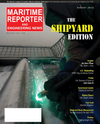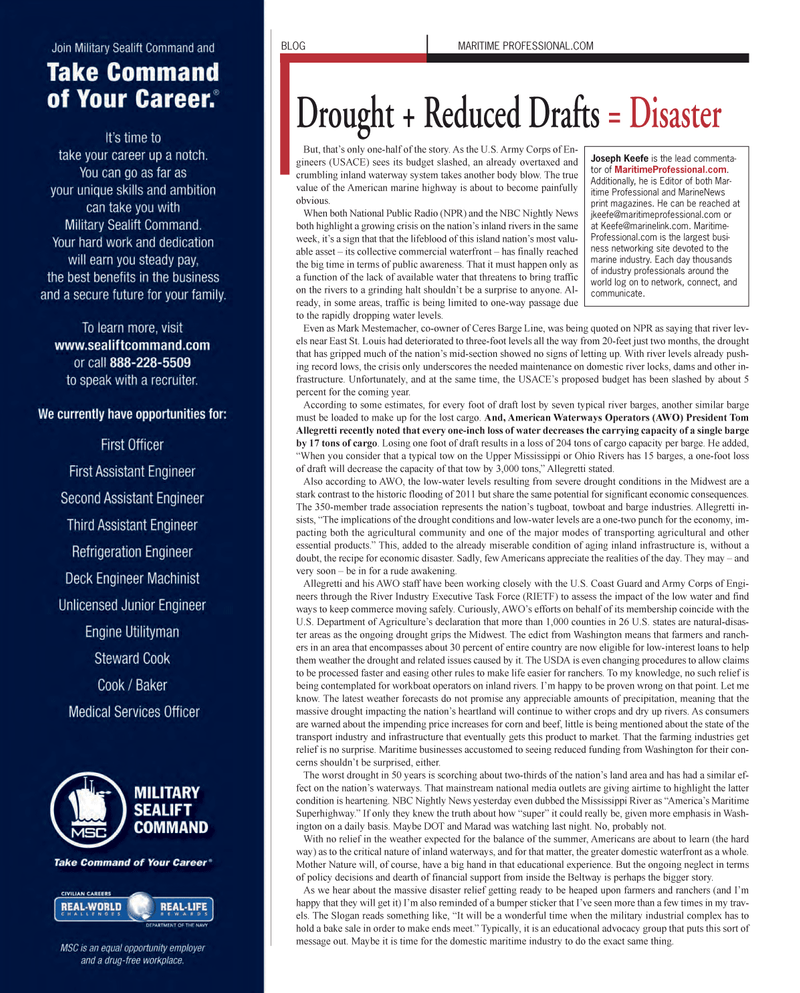
Page 8: of Maritime Reporter Magazine (August 2012)
The Shipyard Edition
Read this page in Pdf, Flash or Html5 edition of August 2012 Maritime Reporter Magazine
BLOGMARITIME PROFESSIONAL.COMDrought + Reduced Drafts = Disaster But, that?s only one-half of the story. As the U.S. Army Corps of En- gineers (USACE) sees its budget slashed, an already overtaxed and crumbling inland waterway system takes another body blow. The true value of the American marine highway is about to become painfully obvious. When both National Public Radio (NPR) and the NBC Nightly News both highlight a growing crisis on the nation?s inland rivers in the same week, it?s a sign that that the lifeblood of this island nation?s most valu- able asset ? its collective commercial waterfront ? has finally reached the big time in terms of public awareness. That it must happen only as a function of the lack of available water that threatens to bring traffic on the rivers to a grinding halt shouldn?t be a surprise to anyone. Al- ready, in some areas, traffic is being limited to one-way passage due to the rapidly dropping water levels. Even as Mark Mestemacher, co-owner of Ceres Barge Line, was being quoted on NPR as saying that river lev- els near East St. Louis had deteriorated to three-foot levels all the way from 20-feet just two months, the drought that has gripped much of the nation?s mid-section showed no signs of letting up. With river levels already push- ing record lows, the crisis only underscores the needed maintenance on domestic river locks, dams and other in- frastructure. Unfortunately, and at the same time, the USACE?s proposed budget has been slashed by about 5 percent for the coming year. According to some estimates, for every foot of draft lost by seven typical river barges, another similar barge must be loaded to make up for the lost cargo. And, American Waterways Operators (AWO) President Tom Allegretti recently noted that every one-inch loss of water decreases the carrying capacity of a single barge by 17 tons of cargo . Losing one foot of draft results in a loss of 204 tons of cargo capacity per barge. He added, ?When you consider that a typical tow on the Upper Mississippi or Ohio Rivers has 15 barges, a one-foot loss of draft will decrease the capacity of that tow by 3,000 tons,? Allegretti stated. Also according to AWO, the low-water levels resulting from severe drought conditions in the Midwest are a stark contrast to the historic flooding of 2011 but share the same potential for significant economic consequences. The 350-member trade association represents the nation?s tugboat, towboat and barge industries. Allegretti in- sists, ?The implications of the drought conditions and low-water levels are a one-two punch for the economy, im- pacting both the agricultural community and one of the major modes of transporting agricultural and otheressential products.? This, added to the already miserable condition of aging inland infrastructure is, without a doubt, the recipe for economic disaster. Sadly, few Americans appreciate the realities of the day. They may ? and very soon ? be in for a rude awakening. Allegretti and his AWO staff have been working closely with the U.S. Coast Guard and Army Corps of Engi- neers through the River Industry Executive Task Force (RIETF) to assess the impact of the low water and find ways to keep commerce moving safely. Curiously, AWO?s efforts on behalf of its membership coincide with the U.S. Department of Agriculture?s declaration that more than 1,000 counties in 26 U.S. states are natural-disas- ter areas as the ongoing drought grips the Midwest. The edict from Washington means that farmers and ranch- ers in an area that encompasses about 30 percent of entire country are now eligible for low-interest loans to help them weather the drought and related issues caused by it. The USDA is even changing procedures to allow claims to be processed faster and easing other rules to make life easier for ranchers. To my knowledge, no such relief is being contemplated for workboat operators on inland rivers. I?m happy to be proven wrong on that point. Let me know. The latest weather forecasts do not promise any appreciable amounts of precipitation, meaning that the massive drought impacting the nation?s heartland will continue to wither crops and dry up rivers. As consumers are warned about the impending price increases for corn and beef, little is being mentioned about the state of the transport industry and infrastructure that eventually gets this product to market. That the farming industries get relief is no surprise. Maritime businesses accustomed to seeing reduced funding from Washington for their con- cerns shouldn?t be surprised, either. The worst drought in 50 years is scorching about two-thirds of the nation?s land area and has had a similar ef- fect on the nation?s waterways. That mainstream national media outlets are giving airtime to highlight the latter condition is heartening. NBC Nightly News yesterday even dubbed the Mississippi River as ?America?s Maritime Superhighway.? If only they knew the truth about how ?super? it could really be, given more emphasis in Wash- ington on a daily basis. Maybe DOT and Marad was watching last night. No, probably not. With no relief in the weather expected for the balance of the summer, Americans are about to learn (the hard way) as to the critical nature of inland waterways, and for that matter, the greater domestic waterfront as a whole. Mother Nature will, of course, have a big hand in that educational experience. But the ongoing neglect in terms of policy decisions and dearth of financial support from inside the Beltway is perhaps the bigger story. As we hear about the massive disaster relief getting ready to be heaped upon farmers and ranchers (and I?m happy that they will get it) I?m also reminded of a bumper sticker that I?ve seen more than a few times in my trav- els. The Slogan reads something like, ?It will be a wonderful time when the military industrial complex has to hold a bake sale in order to make ends meet.? Typically, it is an educational advocacy group that puts this sort of message out. Maybe it is time for the domestic maritime industry to do the exact same thing. Joseph Keefeis the lead commenta-tor of MaritimeProfessional.com .Additionally, he is Editor of both Mar-itime Professional and MarineNews print magazines. He can be reached at [email protected] or at [email protected]. Maritime-Professional.com is the largest busi- ness networking site devoted to themarine industry. Each day thousands of industry professionals around the world log on to network, connect, andcommunicate.MR#8 (1-9):MR Template 8/13/2012 2:12 PM Page 8

 7
7

 9
9
